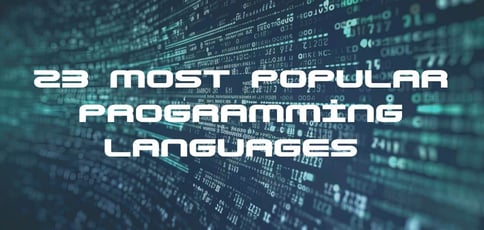
Interestingly enough, the first programming language wasn’t invented during the birth of the electronic computer. Instead, it was instrumental in making the Analytical Engine, a primitive mechanical computer, in 1883. Ada Lovelace, who is referred to as the first computer programmer, and Charles Babbage used the computer algorithm while designing the Analytical Engine.
Since then, the programming field has evolved to include various languages for different use cases, from frontend and backend development to other more specific classifications such as scripting and functional frameworks.
As technology has grown more dominant in everyday life, different career paths and industries have also emerged to manage and develop new tech arrivals. Today, aspiring developers can choose from a myriad of programming languages to master and enter their preferred field. Below, we review the world’s top programming languages and their history.
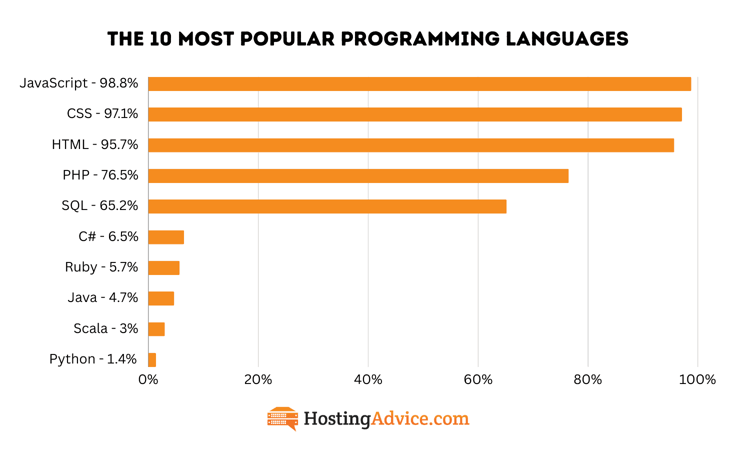
1. JavaScript – Used By 98.8% of the World’s Websites
JavaScript is one of the most popular programming languages in the world. Much of its success is due to its usability. Not only is it a great programming language for code beginners, but it is also essential to assembling the World Wide Web. Its name is mentioned in the upper echelons of programming languages, alongside HTML and CSS, for creating the web as we know it.
Developers have used JavaScript to create 98.8% of the world’s websites, managing the client side and webpage behavior with the language.1 JavaScript has come a long way from its inception in 1995. Previously marketed as Java’s “younger brother,” JavaScript was originally named LiveScript and then became a fully independent language, rising from the remnants of any sibling rivalry.
2. CSS – Used by 97.1% of the World’s Websites
CSS, also known as Cascading Style Sheets, is another prominent frontend programming language. About 97.1% of websites use CSS.2 CSS, JavaScript, and HTML are pillars of web development and work in conjunction to create almost everything we see on a webpage.
As its name suggests, CSS is in charge of styling HTML tags, which include the text in a document, the heading, and other elements. In short, it is integral to the setup of a web browser display, showing why its usage rate is so high.
CSS is also an easier language to learn compared to other languages. Two of its most popular frameworks include Bootstrap and Animate, which have 18.4% and 9.5% web usage rates, respectively.3 These toolkits make working on frontend development with JavaScript, CSS, and HTML a breeze.
3. HTML – Used by 95.7% of the World’s Websites
HTML is the cornerstone of the World Wide Web. In use since 1993, HTML, along with CSS and JavaScript, has built the web into its current, dominating form. About 95.7% of the world’s websites use HTML.4
Over the years, HTML has undergone several updates and is currently on its latest version HTML5, which has played a hand in the development of Instagram, LinkedIn, and Netflix.
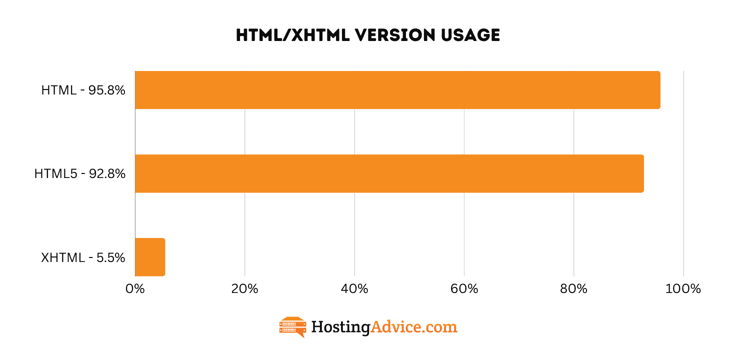
HTML5 and HTML are both easy-to-learn and accessible languages, with many platforms offering their curriculum for free. Unlike HTML, HTML5 supports audio and video and other functionalities, including API, multimedia, and new tags. Nearly all (92.8%) websites use HTML5 as their markup language as of 2024.4
4. PHP – Used by 76.5% of the World’s Websites
Like JavaScript, PHP has also helped the internet become what it is today, but on the opposite of the threshold. Its use comes into play on the server side. PHP is responsible for developing some of the most popular sites on the web, including Facebook and Yahoo.
PHP shares another similarity with JavaScript — it too was introduced in 1995. Rasmus Lerdorf developed PHP to assist engineers during web development. With PHP, developers can create and maintain websites and all the backend functionality that works behind the scenes to give us the stunning websites we have today. That said, programmers used PHP to develop more than 76% of all websites.5
5. SQL — Used by 65.2% of the World’s Websites
SQL is one of the top programming languages for database management. Its acronym stands for Structured Query Language, and its powerful tooling allows developers to access and manipulate data quickly. Teams can use SQL in various environments, from eCommerce applications to data warehouses.
Among the oldest in this bunch, SQL launched in 1972 alongside Smalltalk and C. Donald Chamberlain and Raymond Boyce created SQL for IBM to help developers modify and view computer data. Microsoft and Accenture are two top brands that continue to use SQL today. As for its use, more than 65% of the world’s websites use SQL.6
6. C# – Used by 6.5% of the World’s Websites
C#, or ASP.NET, came on the heels of a new millennium, launching in the year 2000. Closely tied to the .NET framework, C# was built by Microsoft as a part of its .NET initiative. It has since become the primary programming language for .NET development. Today, about 6.5% of websites leverage C#.7
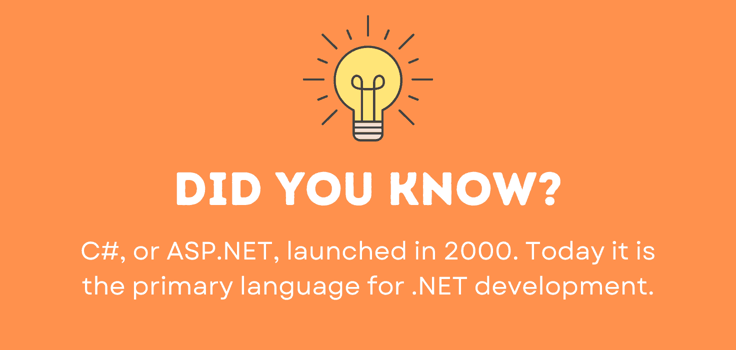
If the name doesn’t give it away, C# shares several similarities with the programming language C++. Microsoft developed it as a combination of C++ and Visual Basic, but it is also a lot like Java. Websites that use C# include Microsoft.com, Adobe.com, Dell.com, and MayoClinic.com. Although C# can be used to create almost everything, it is best suited to Windows, Android, and iOS applications.
7. Ruby – Used by 5.7% of the World’s Websites
Yukihiro Matsumoto created Ruby in 1995 with a sprinkle of five other programming languages: Perl, Smalltalk, Lisp, Ada, and Eiffel. Together, they helped make Ruby’s general-purpose architecture. Ruby is ideal for various programming jobs. It is also ultra-flexible, allowing developers to remove or redefine any part of its structure. More than 5% of all websites use Ruby.8
Since its release in 1993, Ruby has gone on to become one of the most used backend languages in the world. It is widely used for web applications, with brands like Snapchat, Hulu, and Discord leveraging it frequently. Designed with human-friendly syntax, Ruby is a valuable programming partner for students and developers.
8. Java – Used by 4.7% of the World’s Websites
About 4.7% of websites use Java, but don’t let the percentage sway you.9 Java is still a prevalent programming language. As of 2023, more than 30% of developers used Java for their software projects.10 Its popularity can be attributed to its “write once, run anywhere” principle, which allows developers to run compiled Java code on any platform without recompiling it.
Similar to JavaScript and PHP, Java was introduced to the programming world in 1995. Because it is general-purpose, developers can use Java for a variety of projects, from web apps to big data tools. Java has built an extensive online community over the years, where programmers can support one another along their development journey.
9. Scala – Used by 3% of the World’s Websites
Created by Martin Odersky, Scala entered the programming field in 2003. Modeled after Java, Scala is highly compatible with its predecessor and shares many of the same traits. But like other look-alikes, you’ll find the differences upon closer examination. Unlike Java, Scala includes features of functional programming, is more concise, and has easier-to-read syntax.

About 3% of the world’s websites use Scala.11 Websites that use Scala include Wix.com and Pluto.tv. Developers can use Scala for anything they would use Java for. But it is especially beneficial for Android systems and data analytics.
10. Python – Used by 1.4% of the World’s Websites
Python is a mainstay in the developer community, and that is evident in its usage rate. In 2023, almost half (49.3%) of developers used Python as their server-side language.10 Although its website use (1.4%) may seem small compared to others on this list, it is still active in other development workloads and provides a great launching pad for beginner programmers.12
Its code readability, ease of use, and flexibility make coding less intimidating and more accessible. That means coders who buckle down on its curriculum can learn it quickly and start building applications and websites in no time. Users leverage Python for everything from video games to business applications, which probably explains why its number is lower in the website category. Developers are busy using its flexibility for a million other things.
11. TypeScript
TypeScript sounds a lot like JavaScript. That’s because Microsoft created it as a superset of JavaScript. Since it is a typed version of JavaScript, developers can use it to create anything JavaScript-based. Its static typing capabilities allow users to take their JavaScript-based projects a step further, enabling them to build for both client-side and server-side executions as well as large applications.
Although it’s a newcomer to the programming world, released in 2012, TypeScript has gained much traction in its short history. Respondents voted it the most adopted technology in a 2021 State of JavaScript survey. Additionally, over 38% of developers used TypeScript for their projects in 2023.10
12. C++
In 1983, one of the world’s game changers was born. C programmer Bjarne Stroustrup developed C++ as a modified version of C. Its modification included new features such as templates, classes, and virtual jobs. From there, C++ has grown in popularity and was voted one of the top programming languages in 2003.
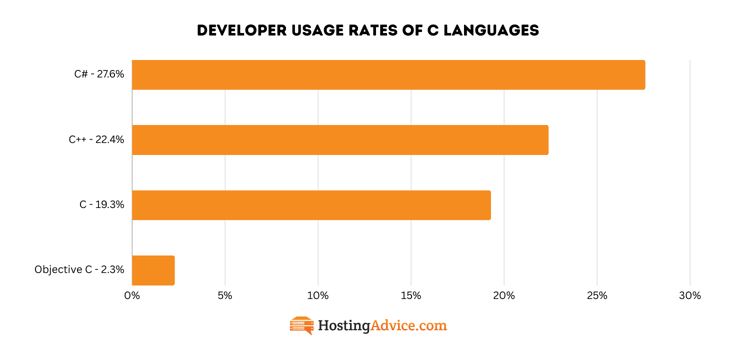
Several programs and platforms use C++, including PlayStation, Nintendo 64, and Adobe Photoshop. Its impressive computing performance makes it a stellar candidate for system programming and embedded systems, showing why many developers use it for game engines, telecommunication networks, and multimedia software. About 22% of developers used it in 2023.10 Another highlight is that it’s much easier to learn than its predecessor, C.
13. C
The original C. It’s the one that started it all, spawning two successors – C++ and C#. It has influenced the development of Java, JavaScript, Python, and many other languages. Created by Dennis Ritchie in 1972, C is considered the first high-level programming language. It simplified the development of complex software by making code more human-friendly and read less like machine code.
Since it is a general-purpose language, C can be used in various programs and applications. In 2023, about 19% of developers used C worldwide.10 Although older than most programming languages on this list, C is still a valuable choice in developer circles. Coders can see it used primarily in building operating systems, language compilers, utilities, and drivers.
14. Go
Google developed Go in 2009 as a solution for large systems programming issues. It has since evolved into a multipurpose tool, ideal for web applications, cloud-based platforms, and containers. Go takes after C and C++ and shares many of their qualities, including syntax familiarities and features such as structural typing.
Go is one of the fastest growing languages in the developer community, due to its ease of use and agility. Its user-friendly structure and syntax familiarity made it a top choice in 2023, with its global usage percentage at 13%.10 Companies, including Twitch and Uber, leverage Go within their organizations.
15. Rust
Rust is never going out of style — at least not in the near future. Graydon Hoare invented Rust in 2015, and it has since become a favorite in the developer wheelhouse. A multi-paradigm and general-purpose programming language, Rust is loved for its speed, concurrency, and memory safety.
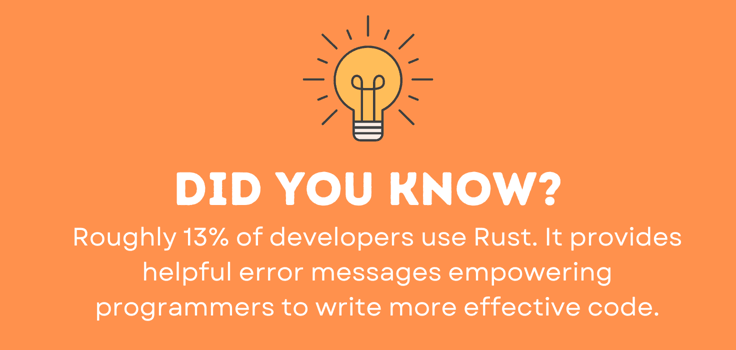
Its high-performance and versatile structure allows developers to work on various programs, including game engines, operating systems, and browser components. Another highlight of Rust is its friendly compiler that provides helpful error messages, empowering programmers to write more effective code. About 13% of developers worldwide used Rust in 2023.10
16. Kotlin
Kotlin is another one of the more modern languages on this list. Designed by JetBrains in 2011, it is a cross-platform and general-purpose programming language with type interference. Kotlin mirrors several qualities of Java and is highly interoperable with it. Some notable brands that leverage Kotlin include Pinterest, Coursera, and PostMates.
Google has also designated Kotlin as one of its primary languages, using it for most of its Android development. Alongside its Google recognition, Kotlin’s characteristics play a major role in its popularity. It is easy to learn, less error-prone, and packed with features. About 9% of software developers used Kotlin in 2023.10
17. Assembly
Assembly is significant, as it helped revolutionize how programmers interact with computers. Making its way into programming in 1949, Assembly was designed to simplify machine code for writing instructions for processors. It’s a low-level language, meaning it is as close as you can get to machine code language.
Assembly language operates as a bridge between computer hardware and high-level languages. It communicates with underlying hardware using an assembler, which translates it into machine language. Although Assembly is not widely used, since modern computers are easier to program, it is still helpful in some cases for speed optimization and driver development. Around 5% of software developers used Assembly language in 2023.10
18. Swift
Apple developed Swift in 2014 as a replacement for Objective-C, C, and C++. Its development allowed Apple a more streamlined language, enabling users to create programs for mobile devices and computers. This move helped improve functionality across the board for Apple software development.
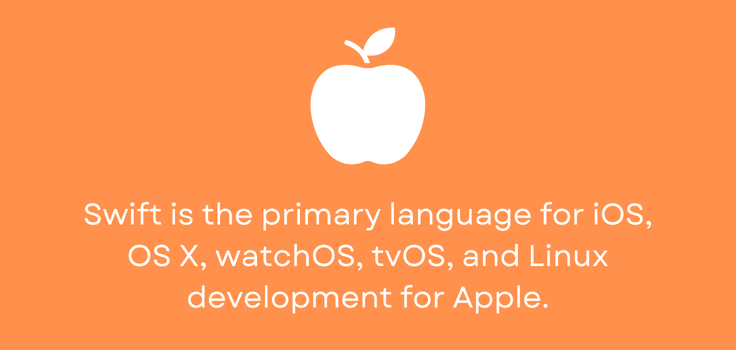
Swift is now the primary language for iOS, OS X, watchOS, tvOS, and Linux development in Apple. It is highly compatible with Apple frameworks and works well with any existing Objective-C code for Apple systems. Other highlights of Swift include high performance, safety, and its focus on software design. About 4.6% of the globe’s developers used Swift in 2023.10
19. R
Statisticians Ross Ihaka and Robert Gentleman created R in 1993. The duo designed the open-source programming language for two purposes that fit right in their wheelhouse: statistical computing and data visualization. With big data’s ascent in modern society, R has become a cornerstone for data miners and analysts.
R’s structure and libraries allow developers to incorporate various statistical and graphical techniques, including clustering and linear and nonlinear modeling. Programmers in data industries can find R valuable for statistical analysis and building high-quality data visualization. In 2023, more than 4% of developers used R in their workloads.10
20. Visual Basic
Visual Basic entered the programming field the same year as Python in 1991. Microsoft created Visual Basic to simplify the coding process by adding drag-and-drop menus and functionality. With Visual Basic, developers can drag and drop scripts simultaneously, which makes changing large pieces of code easier.
Although Visual Basic is not as popular as its successor, C#, it is still a valuable tool for .NET developers. Programmers can leverage it to develop a varied range of Windows and Office applications as well as web and mobile applications. About 4% of the world’s software developers used Visual Basic in 2023.10
21. MATLAB
Cleve Moler created MATLAB in 1978 as a tool for writing math programs. Its matrix-based structure allows programmers to express complex computational mathematics in a natural format. This way, developers can use MATLAB for matrix manipulations, data and function plotting, and algorithm implementation.
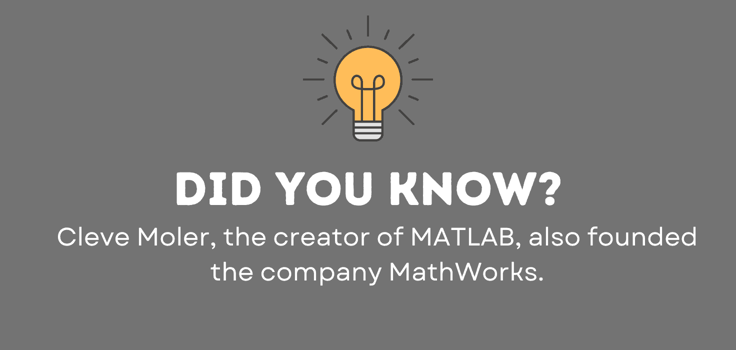
MATLAB is a perfect companion for data scientists and engineers. It can help them with data analytics, math models, and research verification. It also has easy-to-use computation and visualization tools. Around 3.8% of developers used MATLAB for their workloads in 2023.10
22. Perl
Perl is a general-purpose and dynamic programming language. Larry Wall originally created Perl as a text editor in 1987. Since then, Perl has become a multipurpose tool for developing programs that can run on more than 100 platforms and do multiple functions for various industries. Its use cases include database applications, network programming, and web development.
Regarded as “the Swiss army knife” of scripting, developers leverage Perl for a variety of tasks. It has become a top option for prototyping and large development projects. In 2023, about 2.4% of developers used Perl.10 Although its usage rate is lower than for other programming languages, Perl is still very much alive more than 40 years after its release. And that’s not an easy feat.
23. Objective-C
We’ve hit the final C on the list. Tom Love and Brad Cox developed Objective-C for Apple in 1983. After its introduction, Objective-C became the primary programming language for developers when writing Apple software. Objective-C is a mixture of C and Smalltalk. Using C as the base, Tom and Brad added some features and syntax from Smalltalk to complete the programming language.
Today, many Apple systems still have existing Objective-C code, including Mac OSX and iOS applications. However, Swift has become Apple’s main alternative after its introduction in 2014. Since Objective-C has been replaced, its usage number has decreased. In 2023, a little over 2% of developers worldwide used Objective-C for their programs.10
Run With Programming
Programming has come a long way, from low-level machine code languages to high-level and readable code on modern computers. Developers now have an abundance of programming languages to run their workloads and create their applications. Mastering just one can help budding programmers launch successful careers.
As the world becomes increasingly digital, web and mobile applications will continue to be essential. The increased demand for digital products has prompted the emergence of new languages, such as Swift and Rust. Older languages also continue to reign supreme. The future sure is bright for software development.
Sources and Other Reading
- https://w3techs.com/technologies/details/cp-javascript/
- https://w3techs.com/technologies/details/ce-css
- https://w3techs.com/technologies/overview/css_framework
- https://w3techs.com/technologies/details/ml-html5
- https://w3techs.com/technologies/details/pl-php
- https://gitnux.org/sql-server-statistics
- https://w3techs.com/technologies/details/pl-aspnet
- https://w3techs.com/technologies/details/pl-ruby
- https://w3techs.com/technologies/details/pl-java
- https://www.statista.com/statistics/793628/worldwide-developer-survey-most-used-languages/
- https://w3techs.com/technologies/details/pl-scala
- https://w3techs.com/technologies/details/pl-python







